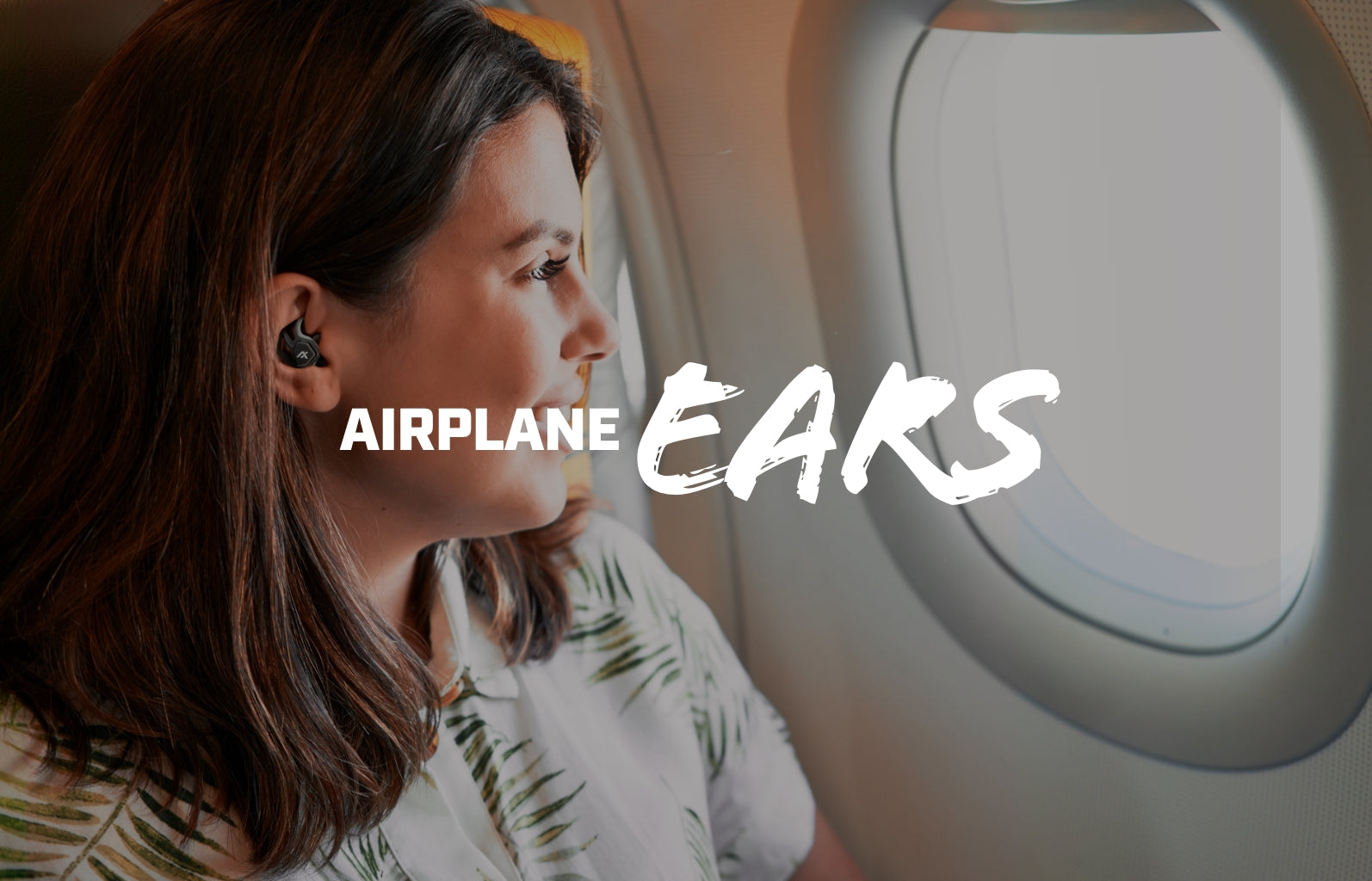If you’ve felt pressure, popping, or muffled hearing during takeoff or landing, you’ve had a run-in with airplane ears. This common condition, also called ear barotrauma, happens when the rapid change in cabin pressure outpaces your ears’ ability to equalize. It’s usually harmless, but it can seriously mess with your comfort—and in rare cases, lead to ear infections or even a ruptured eardrum.
Whether you’re a once-a-year vacationer or racking up frequent flyer miles, ear discomfort can turn an easy flight into an annoying experience. The good news? There are practical ways to stay ahead of the pressure. In this guide, we’ll break down what causes airplane ear, who’s most at risk, how to prevent it, and why AXIL’s X30i earplugs are a must-pack for pain-free travel.
What Is Airplane Ear and Why Does It Happen?
Airplane ears happen when your middle ear struggles to match cabin pressure changes, especially during takeoff and landing. That imbalance can stretch the eardrum and create a feeling of fullness, dull hearing, or pain.
The real culprit? Your Eustachian tube—a small passage connecting your ear to the back of your nose. If it can’t open quickly enough (thanks to congestion, illness, or anatomy), pressure builds up, and symptoms set in. It’s a common scenario when flying with a cold, allergies, or sinus issues.
Who Is Most at Risk for Airplane Ear?
Some travelers are more prone to ear pain than others. Kids and infants are high-risk because their Eustachian tubes are still developing. Adults with allergies, colds, sinus infections, or a recent ear procedure are also more likely to deal with discomfort.
Frequent flyers, scuba divers, and folks with chronic nasal issues may struggle to equalize pressure consistently. If you’ve experienced barotrauma before or deal with sensitive ears, it’s worth taking preventive measures every time you fly.
7 Expert-Approved Ways to Prevent Airplane Ear Pain
Avoiding airplane ear symptoms doesn’t require complicated tools. You just need to support your body's natural response to pressure changes and make smart travel choices. Here’s how:
1. Swallow, Yawn, or Chew Gum
These simple actions help open the Eustachian tube and balance pressure. Keep gum, lozenges, or snacks on hand—and for kids, a bottle or pacifier does the trick. Do it consistently during takeoff and landing for best results.
2. Use the Valsalva Maneuver
Gently blow with your mouth closed and nose pinched to push air into your middle ear. This classic pressure-equalizing technique can work wonders, but don’t overdo it—especially if you’ve had ear issues.
3. Stay Hydrated and Avoid Alcohol
Cabin air is dry, which can dehydrate you and irritate your airways. Drink water regularly, and limit alcohol or caffeine. Moist airways equal better pressure regulation and happier ears.
4. Use a Nasal Spray Before Takeoff
Decongestant sprays reduce inflammation in the nasal passages, helping the Eustachian tubes stay open. Use them 30 minutes before takeoff and again before descent—just don’t rely on them long-term without medical advice.
5. Don’t Sleep During Ascent/Descent
This is when pressure shifts the most, and your body needs you alert to manage it. Hold off on napping until the plane reaches cruising altitude or lands.
6. Fly When You’re Healthy
If you're feeling congested or under the weather, try to delay your trip. Flying sick can intensify pressure problems. If you can’t postpone, double down on hydration, nasal sprays, and earplugs.
7. Wear Pressure-Regulating Earplugs
AXIL’s X30i earplugs are designed to gradually equalize pressure while reducing engine noise. They’re especially useful during takeoff and landing and offer a reusable, discreet solution for flyers prone to discomfort.
Spotlight: How AXIL X30i Earplugs Help Prevent Airplane Ear
The X30i isn’t your average travel earplug. Designed with an internal valve system, it regulates the flow of air into your ears, helping ease the pressure difference during altitude changes. The result? Less pain, more comfort, and no more dread at 30,000 feet.
With a triple-flange design made from soft, medical-grade silicone, the X30i provides a solid, flexible seal. It blocks background noise while letting in gradual pressure shifts—ideal for sensitive ears or those recovering from ear issues.
AXIL brings over 60 years of hearing protection expertise to every product, and the X30i reflects that legacy. It’s a smart upgrade for any traveler looking to protect their ears and upgrade their in-flight experience.
Traveling with Ear Sensitivity: Additional Tips for a Comfortable Flight
If you’re a frequent flyer with ear sensitivity, a little prep goes a long way. Pack a small kit: water bottle, nasal spray, your X30i plugs, gum, and maybe some antihistamines if allergies are a concern. Choose an aisle seat so you can get up and move if needed, and avoid heavy, mucus-producing foods pre-flight.
If you’re flying with kids, recovering from illness, or have chronic congestion, talk to your doctor about travel-safe strategies. The more you know, the more comfortable (and quiet) your flight will be.
Final Thoughts: Fly in Comfort, Protect Your Hearing
Airplane ears don’t have to be part of the travel experience. With the right techniques and tools, you can keep your ears pain-free from takeoff to touchdown. Whether it’s chewing gum, using nasal spray, or popping in AXIL’s X30i earplugs, small steps make a big difference.
Built for comfort, performance, and real-world protection, the X30i earplugs help you travel smarter. Don’t let pressure ruin your trip. Fly better—and hear better—with AXIL.








 Accessibility
Accessibility

Share:
Silicone vs. Foam Ear Plugs: Which AXIL Option Is Best for Your Ears?
How to Make Ringing in Ears Stop After a Concert